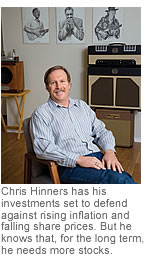How to Move Back Into the Market
You need a plan and a schedule for leaving the bomb shelter behind.

A few months ago, Chris Hinners, a computer-network engineer, decided that the spate of negative headlines about the economy required drastic action. He switched all the money in his 401(k) plan to stuff he figures will hold its value "if the American economy goes the way of the British Empire."
He put nearly one-third of his $100,000 balance into a money-market fund and one-fourth in Merk Hard Currency (symbol MERKX), a fund designed to benefit from a weakening dollar. He invested the rest in a gold fund, Canadian and global growth funds, an energy fund, and Excelsior Value & Restructuring (UMBIX), a Kiplinger 25 member that has a big weighting in energy and materials stocks.

Chris, who is 50, single and lives in Austin, Tex., is directing new contributions to the money fund. During the stock market's recent setback, only the gold and currency funds held up, although most of Chris's picks have steadied since the Federal Reserve began cutting interest rates. But Chris expects inflation to accelerate and U.S. stocks to tank again.
From just $107.88 $24.99 for Kiplinger Personal Finance
Become a smarter, better informed investor. Subscribe from just $107.88 $24.99, plus get up to 4 Special Issues

Sign up for Kiplinger’s Free Newsletters
Profit and prosper with the best of expert advice on investing, taxes, retirement, personal finance and more - straight to your e-mail.
Profit and prosper with the best of expert advice - straight to your e-mail.
Chris knows he can't hide forever and expect to beat inflation over the 15 years before he retires. So he plans to emerge from his bomb shelter in the second half of 2008 and begin to build a more normal portfolio.
But it's hard to know when and how to resume a growth strategy. Move all at once and a sinking market can whack your wealth. Delay and you're certain to miss more rallies. "There are plenty of opportunities to get whipsawed," Chris acknowledges.
Moreover, defensive investments can lose money, too -- just ask investors in real estate. Gold, which is at record prices, endured a 20-year-long bear market before embarking on its current rally. Even Treasuries can lose money. Ten-year Treasury notes recently yielded a mere 3.6%. If yields were to rise one percentage point, which is certainly possible, the ten-year note would lose about 8% of its value.
Most advisers suggest holding some stocks even in a recession -- figure 75%, at most, particularly if you're 50 or older. The emphasis should be on large, high-quality companies with a global presence. But adding to your stock holdings during a recession is especially tricky. That's because market recoveries normally begin well before a recession ends and when pessimism about the economy and stocks is rampant.
Balanced choices
Because Chris doesn't want to trade much, a sensible idea would be to switch a slug of his assets -- say, 80% -- to a well-diversified balanced fund. Fidelity Asset Manager 70% (FASGX), which, as its name suggests, keeps 70% of its assets in stocks, is a sound choice. So is Janus Balanced (JABAX), which has 60% in stocks. (Chris invests his 401(k) money through a Fidelity brokerage account, so he can buy these funds without sales charges.)
He should keep the remaining 20% of his money in cash until it's clear that the markets have settled down and the economy shows signs of bottoming.
There's still the question of timing. The common advice for implementing a sweeping strategic shift is to stagger your moves over at least three months. But Steve Horan, head of private wealth counseling for the CFA Institute, says that once you've decided to put cash back to work, proper diversification offsets the risk of bad timing. "You can't react to past events," he says. "If you want to invest now, go ahead and invest."
Stumped by your investments? Write to us at portfoliodoc@kiplinger.com.
Profit and prosper with the best of Kiplinger's advice on investing, taxes, retirement, personal finance and much more. Delivered daily. Enter your email in the box and click Sign Me Up.

Kosnett is the editor of Kiplinger Investing for Income and writes the "Cash in Hand" column for Kiplinger Personal Finance. He is an income-investing expert who covers bonds, real estate investment trusts, oil and gas income deals, dividend stocks and anything else that pays interest and dividends. He joined Kiplinger in 1981 after six years in newspapers, including the Baltimore Sun. He is a 1976 journalism graduate from the Medill School at Northwestern University and completed an executive program at the Carnegie-Mellon University business school in 1978.